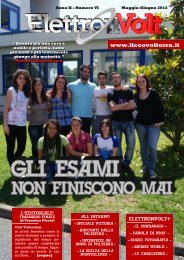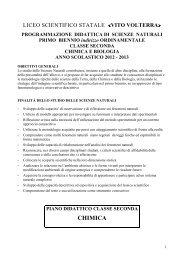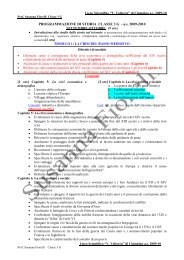Tesina - Liceo Scientifico Statale Vito Volterra
Tesina - Liceo Scientifico Statale Vito Volterra
Tesina - Liceo Scientifico Statale Vito Volterra
You also want an ePaper? Increase the reach of your titles
YUMPU automatically turns print PDFs into web optimized ePapers that Google loves.
In June 1780, Blake was walking towards Basire's shop in Great Queen Street when he was<br />
swept up by a rampaging mob that stormed Newgate Prison in London. Many among the mob were<br />
wearing blue cockades on their caps, to symbolise solidarity with the insurrection in the American<br />
colonies. They attacked the prison gates with shovels and pickaxes, set the building ablaze, and<br />
released the prisoners inside. Blake was reportedly in the front rank of the mob during this attack;<br />
most biographers believe he accompanied the crowd impulsively.<br />
These riots, in response to a parliamentary bill revoking sanctions against Roman Catholicism,<br />
later came to be known as the Gordon Riots; they provoked a flurry of legislation from the<br />
government of George III, as well as the creation of the first police force.<br />
Marriage and early career<br />
In 1782, Blake met John Flaxman, who was to become his patron, and Catherine Boucher, who<br />
was to become his wife. At the time, Blake was recovering from a relationship that had culminated<br />
in a refusal of his marriage proposal. Telling Catherine and her parents the story, she expressed her<br />
sympathy, whereupon Blake asked her, "Do you pity me?" To Catherine's affirmative response he<br />
responded, "Then I love you." Blake married Catherine – who was five years his junior – on 18<br />
August 1782 in St. Mary's Church, Battersea. Illiterate, Catherine signed her wedding contract with<br />
an 'X'. Later, in addition to teaching Catherine to read and write, Blake trained her as an engraver;<br />
throughout his life she would prove an invaluable aid to him, helping to print his illuminated works<br />
and maintaining his spirits throughout numerous misfortunes.<br />
At this time George Cumberland, one of the founders of the National Gallery, became an<br />
admirer of Blake's work. Blake's first collection of poems, Poetical Sketches, was published around<br />
1783. After his father's death, William and his brother Robert opened a print shop in 1784, and<br />
began working with radical publisher Joseph Johnson. Johnson's house was a place of meeting for<br />
some of the leading intellectual dissidents of the time in England: Joseph Priestley, scientist;<br />
Richard Price, philosopher; John Henry Fuseli [7] ; Mary Wollstonecraft, an early feminist; and<br />
Thomas Paine, American revolutionary. Along with William Wordsworth and William Godwin,<br />
Blake had great hopes for the American and French revolution and wore a red liberty cap in<br />
solidarity with the French revolutionaries, but despaired with the rise of Robespierre and the Reign<br />
of Terror in the French revolution.<br />
Blake illustrated Original Stories from Real Life (1788; 1791) by Mary Wollstonecraft. They<br />
seem to have shared some views on sexual equality and the institution of marriage, but there is no<br />
evidence proving without doubt that they actually met. In 1793's Visions of the Daughters of Albion,<br />
Blake condemned the cruel absurdity of enforced chastity and marriage without love and defended<br />
could appear alongside words in the manner of earlier illuminated manuscripts. He then etched the<br />
plates in acid in order to dissolve away the untreated copper and leave the design standing in relief<br />
(hence the right of women to complete self-fulfillment.<br />
Relief etching<br />
In 1788, at the age of 31, Blake began to experiment with relief etching, a method he would use<br />
to produce most of his books, paintings, pamphlets and of course his poems, including his longer<br />
'prophecies' and his masterpiece the "Bible". The process is also referred to as illuminated printing,<br />
and final products as illuminated books or prints. Illuminated printing involved writing the text of<br />
the poems on copper plates with pens and brushes, using an acid-resistant medium. Illustrations the<br />
name). This is a reversal of the normal method of etching, where the lines of the design are exposed<br />
to the acid, and the plate printed by the intaglio method. Relief etching, which Blake invented, later<br />
became an important commercial printing method. The pages printed from these plates then had to<br />
be hand-colored in water colors and stitched together to make up a volume. Blake used illuminated<br />
printing for most of his well-known works, including Songs of Innocence and Experience, The Book<br />
of Thel, The Marriage of Heaven and Hell, and Jerusalem.<br />
39


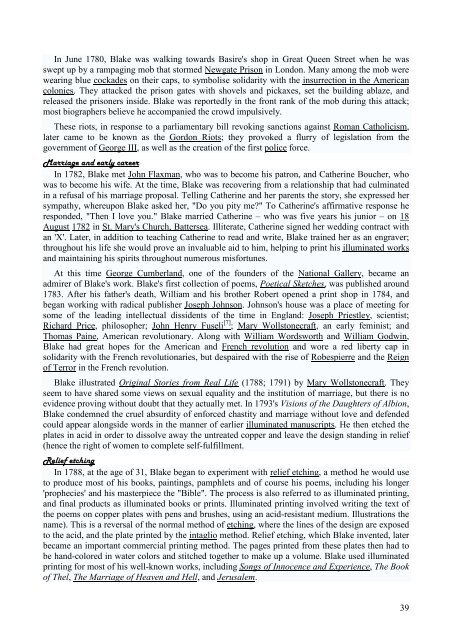
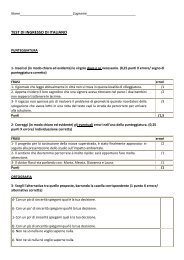
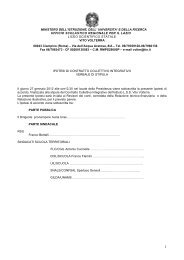
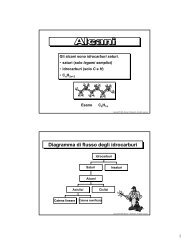

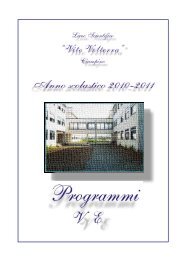
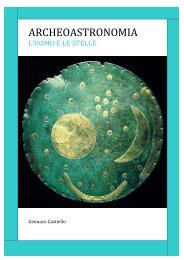

![SETTEMBRE – NOVEMBRE [20 ore] - Liceo Scientifico Statale Vito ...](https://img.yumpu.com/16098766/1/184x260/settembre-novembre-20-ore-liceo-scientifico-statale-vito-.jpg?quality=85)

